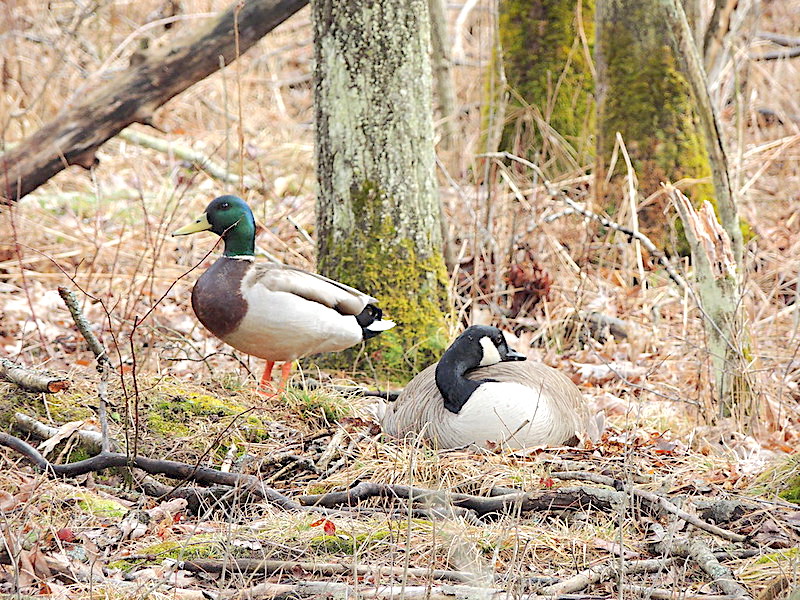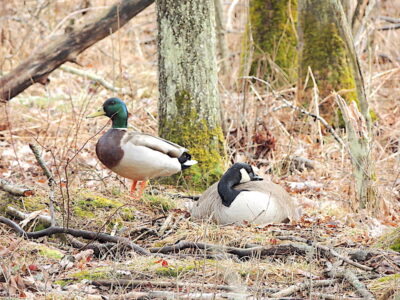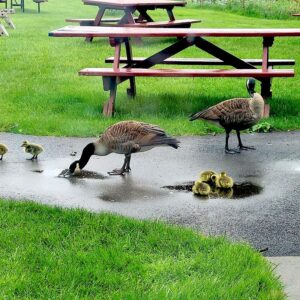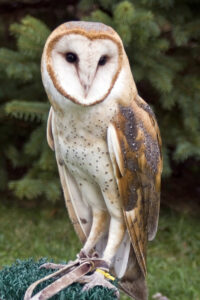Fall is duck and goose season

Mallards and geese both spend time on the shores of ponds, and nest on land. Like the two pictured in this photo.
- Mallards and geese both spend time on the shores of ponds, and nest on land. Like the two pictured in this photo.
- Shown are Goslings practicing being dabbler and puddle jumpers. Canada Geese spend a lot of time on land with their goslings.
Since it is a wetland area, the animals living near this road are largely those that are as at-home in the water as they are on land. During the summer, Painted Turtles and Muskrats are common sightings. They are both animals that prefer wetlands with still or slower moving water and a heavy host of plant life. There is also a plethora of water-loving birds that call these spaces along the river and lake ‘home’, especially in the fall.
Living near lakes, ponds, or wetlands make waterfowl sights and sounds a typical occurrence. While ducks can be found along this particular roadway throughout the year, Mallards tend to make an appearance in much larger numbers in the spring and fall. During the spring, I am watching for baby ducks as I drive. In the fall, even though they are all adults, there seem to be so many of them moving around that I make sure to keep an eye on them as I pass them swimming in the water a few feet from the edge of the road.
Mallards are a very common duck sighting year-round across much of North America due to their prevalence, adaptability to urban areas, and metallic coloration. They are dimorphic, so the males and females have different colors and patterns on their plumage, making it easy to tell them apart. Like many birds, the males are more brightly colored than the females. The males use the bright colors to attract their mates, while the females are shades of brown that allow them to camouflage as they sit on their nest and eggs. With Mallards, the males have a distinctive, metallic green head, and a blue metallic stripe on their wings. Females are mostly a mottled brown and white, but they also have the metallic blue stripe to match the males.
When someone uses the term ‘waterfowl’, they are generally talking about the Anseriformes group, which includes ducks, geese, and swans. With over 150 species, there are bound to be some differences in their habitat preferences, diet, and behaviors, in addition to the variation in appearance.

Shown are Goslings practicing being dabbler and puddle jumpers. Canada Geese spend a lot of time on land with their goslings.
Ducks and geese vary in what they eat and how they get their food, and they can generally be broken down into either dabblers or divers.
Diving ducks fully submerge underwater and swim down looking for aquatic insects, plants growing underwater, snails, mollusks, and crustaceans. The shallow lakes and ponds of western NY are filled with all sorts of diving ducks, from scaups and Redheads, to Hooded Mergansers with their mohawk of feathers, and little Buffleheads. These ducks will disappear underwater completely to catch their food and pop up somewhere else, so sometimes you have to be patient to find them.
Dabbling ducks, sometimes also called puddle ducks, find their food closer to the surface of the water, or even just on land. They typically feed on aquatic and land plants, but the more opportunistic of these ducks will also eat invertebrates if they can get them.
You can usually tell if a duck is a dabbler through some quick observation. When in the water, you might see them bob upside down with their heads down in the water and their tailfeathers sticking up in the air. Mallards fall in this category. They are omnivores, so when they turn upside down they could be looking for seeds, roots, leaves, aquatic insects, or snails. What they eat often depends on the season and what happens to be readily available. Other ducks like Wood Ducks, teals, the American Black Duck, and the American Widgeon are also dabbling ducks who stick closer to the surface in their search for food.
And of course, we can’t forget about the ever-present, feisty Canada Goose. They are also dabblers rather than divers, and they feed primarily on plant material, both in the water and on land.
Many of these waterfowl are migratory. They are often migrating in search of food, so the timing of that migration can vary year to year depending on weather, their food sources, and how far they are willing to be from their breeding grounds. Smaller ducks often migrate through September and October, with geese and swans picking up in October and potentially into November.
Mallards migrate each fall and spring from northern areas. Some stop around here for the winter, but most typically head even further south where food is more abundant for the winter months. Fall and winter are also when many Mallards are forming their breeding pairs, so you are likely to see them in pairs amongst the larger migrating group even now. This year, following a trend seen over the last several years, many waterfowl are migrating later in the fall, if at all. With warmer weather, the ducks and geese are moving shorter distances in the fall, and once we pass a certain time of the year, they seem to hunker down and manage winter as best they can.
Head out to ponds, lakes, and wetlands in October and November and you are likely to see flocks of waterfowl. Some of them will continue to remain here over winter, while others are just stopping by on their way through. Some of them, like the Mallards that take up residency on the roadside wetlands near my home, may just continue to move further into the Chadakoin River or a larger lake that will take longer to freeze. Whatever they decide, I will continue to keep an eye out and make way for the ducks.
Audubon Community Nature Center builds and nurtures connections between people and nature. ACNC is located just east of Route 62 between Warren and Jamestown. The trails are open from dawn to dusk and birds of prey can be viewed anytime the trails are open. The Nature Center is open from 10 a.m. until 4:30 p.m. daily except Sunday when it opens at 1 p.m. More information can be found online at auduboncnc.org or by calling (716) 569-2345.



